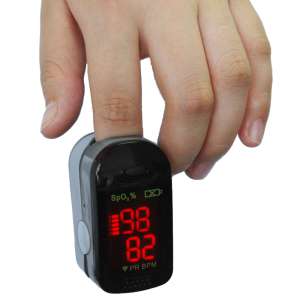 Pulse oximeters are very useful for telling us when you don’t have enough oxygen in the blood. Some people desaturate with exercise. Some people desaturate when they sleep. One of the things we measure in Pulmonary Rehab is saturation at rest, with exercise, and then recovery (how long it takes for your heart rate and oxygen levels to return to normal).
Pulse oximeters are very useful for telling us when you don’t have enough oxygen in the blood. Some people desaturate with exercise. Some people desaturate when they sleep. One of the things we measure in Pulmonary Rehab is saturation at rest, with exercise, and then recovery (how long it takes for your heart rate and oxygen levels to return to normal).
Many people with COPD and ILD are fine at rest, but as soon as they walk across the room, their oxygen levels decrease. You may have had a 6 minute walk test at your doctor’s at some point. We use this information to titrate, or adjust your oxygen flow levels while you exercise. Without enough oxygen, your cells can’t function. Your muscles get very tired very quickly, and you have to stop and rest. Your heart compensates for the low oxygen by beating harder and faster. You may even feel faint.
In a 6 week formal Pulmonary Rehab program, we ask patients to measure 2 things with each exercise: breathlessness, and how hard were they working their muscles to do the exercise. Think of 30 minutes of window shopping at the mall vs. 30 minutes of walking in your neighborhood, without stopping to chat with anyone. We put these 3 things together to titrate your oxygen flowrate. At the end of the program, many graduates want to know where to buy their own pulse oximeter.
Here is what I tell my patients: I want THEM to be able to tell when they need to slow down, stop, or turn up the oxygen. Not a machine. After 6 weeks they are usually pretty good at determining when they are working too hard. So I discourage them from buying one. Towards the end of the program, we play a little game: without looking, I have them guess what their Heart Rate and Saturation are after each exercise. By graduation day, they are generally right on. So if you must, and you feel safer, by all means get one.
If you have no idea what your usual heart rate and oxygen levels are, then I recommend you get one. If you’ve never had an oxygen test of any kind that you can remember, and you feel breathless with any walking or exercise, ask your doctor to please do a walking test. If you don’t have a regular doctor or pulmonologist, and you want to start exercising, then I will recommend you get one for safety reasons.
What kind should I get?
If you have never had a 6 minute walk test, or don’t have a regular doctor, it is very important to know your baseline.
There are many people who should be on supplemental oxygen, but are not. If you buy a pulse oximeter and find that your saturations are less than 88% at rest, you will need to go see a doctor to get a prescription for oxygen.
If you don’t have access to a doctor or clinic, please consider joining as a COPD Success member, for your health’s sake! Meanwhile, here’s what you can do:
First, buy a hospital grade pulse oximeter. You can buy these through E Bay, Amazon.com, even Craigslist. Some medical supply companies may carry them. A good one should run you about $100.
If that’s out of your budget, a cheapie one can be had for anywhere from $10 -30. There are a lot of cheap models out there, but I want you to know your accurate numbers. Oxygen saturation is a slippery slope when your levels are low. If your levels are low, we really need to know HOW low. Brand names such as Massimo are best.
Second, buy one that takes standard AAA or AA batteries.
Lastly, if you do buy a used one, clean it thoroughly with a disinfectant wipe such as Lysol before you use it!
Leave a Reply
You must be logged in to post a comment.